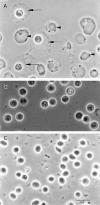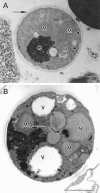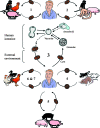New insights on classification, identification, and clinical relevance of Blastocystis spp
- PMID: 18854485
- PMCID: PMC2570156
- DOI: 10.1128/CMR.00022-08
New insights on classification, identification, and clinical relevance of Blastocystis spp
Abstract
Blastocystis is an unusual enteric protozoan parasite of humans and many animals. It has a worldwide distribution and is often the most commonly isolated organism in parasitological surveys. The parasite has been described since the early 1900s, but only in the last decade or so have there been significant advances in our understanding of Blastocystis biology. However, the pleomorphic nature of the parasite and the lack of standardization in techniques have led to confusion and, in some cases, misinterpretation of data. This has hindered laboratory diagnosis and efforts to understand its mode of reproduction, life cycle, prevalence, and pathogenesis. Accumulating epidemiological, in vivo, and in vitro data strongly suggest that Blastocystis is a pathogen. Many genotypes exist in nature, and recent observations indicate that humans are, in reality, hosts to numerous zoonotic genotypes. Such genetic diversity has led to a suggestion that previously conflicting observations on the pathogenesis of Blastocystis are due to pathogenic and nonpathogenic genotypes. Recent epidemiological, animal infection, and in vitro host-Blastocystis interaction studies suggest that this may indeed be the case. This review focuses on such recent advances and also provides updates on laboratory and clinical aspects of Blastocystis spp.
Figures








Similar articles
-
Recent developments in Blastocystis research.Adv Parasitol. 2013;82:1-32. doi: 10.1016/B978-0-12-407706-5.00001-0. Adv Parasitol. 2013. PMID: 23548084 Review.
-
[Isolation of Blastocystis spp. from human hosts and in vitro determination of different morphological forms].Turkiye Parazitol Derg. 2011;35(1):19-22. doi: 10.5152/tpd.2011.05. Turkiye Parazitol Derg. 2011. PMID: 21618186 Turkish.
-
Prevalence and subtype distribution of Blastocystis sp. isolates from poultry in Lebanon and evidence of zoonotic potential.Parasit Vectors. 2018 Jul 4;11(1):389. doi: 10.1186/s13071-018-2975-5. Parasit Vectors. 2018. PMID: 29973261 Free PMC article.
-
Intestinal parasite infections in a rural community of Rio de Janeiro (Brazil): Prevalence and genetic diversity of Blastocystis subtypes.PLoS One. 2018 Mar 9;13(3):e0193860. doi: 10.1371/journal.pone.0193860. eCollection 2018. PLoS One. 2018. PMID: 29522552 Free PMC article.
-
Blastocystis in domesticated and wild mammals and birds.Res Vet Sci. 2021 Mar;135:260-282. doi: 10.1016/j.rvsc.2020.09.031. Epub 2020 Sep 30. Res Vet Sci. 2021. PMID: 33046256 Review.
Cited by
-
Genetic diversity of caprine Blastocystis from Peninsular Malaysia.Parasitol Res. 2013 Jan;112(1):85-9. doi: 10.1007/s00436-012-3107-3. Epub 2012 Sep 8. Parasitol Res. 2013. PMID: 22961236
-
Subtype distribution of Blastocystis in Thai-Myanmar border, Thailand.Korean J Parasitol. 2015 Feb;53(1):13-9. doi: 10.3347/kjp.2015.53.1.13. Epub 2015 Feb 27. Korean J Parasitol. 2015. PMID: 25748704 Free PMC article.
-
Genetic variability of Blastocystis sp. isolated from symptomatic and asymptomatic individuals in Iran.Parasitol Res. 2012 Dec;111(6):2311-5. doi: 10.1007/s00436-012-3085-5. Epub 2012 Sep 5. Parasitol Res. 2012. PMID: 22948205
-
Characterization of subtypes of Blastocystis sp. isolated from patients with urticaria, São Paulo, Brazil.Parasite Epidemiol Control. 2019 Nov 9;7:e00124. doi: 10.1016/j.parepi.2019.e00124. eCollection 2019 Nov. Parasite Epidemiol Control. 2019. PMID: 31872093 Free PMC article.
-
Extensive prevalence and significant genetic differentiation of Blastocystis in high- and low-altitude populations of wild rhesus macaques in China.Parasit Vectors. 2023 Mar 17;16(1):107. doi: 10.1186/s13071-023-05691-7. Parasit Vectors. 2023. PMID: 36932438 Free PMC article.
References
-
- Abe, N. 2004. Molecular and phylogenetic analysis of Blastocystis isolates from various hosts. Vet. Parasitol. 120:235-242. - PubMed
-
- Abe, N., Z. Wu, and H. Yoshikawa. 2003. Molecular characterization of Blastocystis isolates from birds by PCR with diagnostic primers and restriction fragment length polymorphism analysis of the small subunit ribosomal RNA gene. Parasitol. Res. 89:393-396. - PubMed
-
- Abe, N., Z. Wu, and H. Yoshikawa. 2003. Molecular characterization of Blastocystis isolates from primates. Vet. Parasitol. 113:321-325. - PubMed
-
- Abe, N., Z. Wu, and H. Yoshikawa. 2003. Zoonotic genotypes of Blastocystis hominis detected in cattle and pigs by PCR with diagnostic primers and restriction fragment length polymorphism analysis of the small subunit ribosomal RNA gene. Parasitol. Res. 90:124-128. - PubMed
-
- Abou El Naga, I. F., and A. Y. Negm. 2001. Morphology, histochemistry and infectivity of Blastocystis hominis cyst. J. Egypt. Soc. Parasitol. 31:627-635. - PubMed
Publication types
MeSH terms
LinkOut - more resources
Full Text Sources
Other Literature Sources
Miscellaneous

